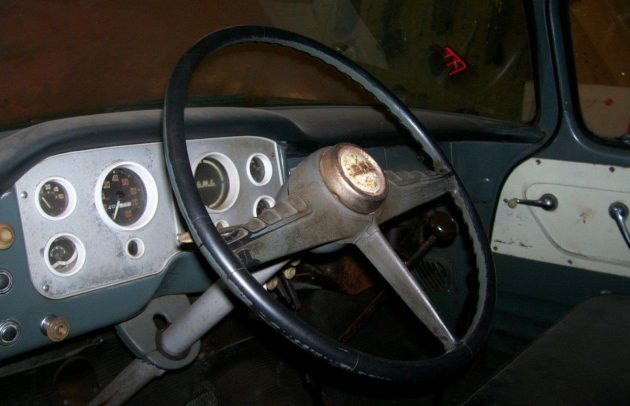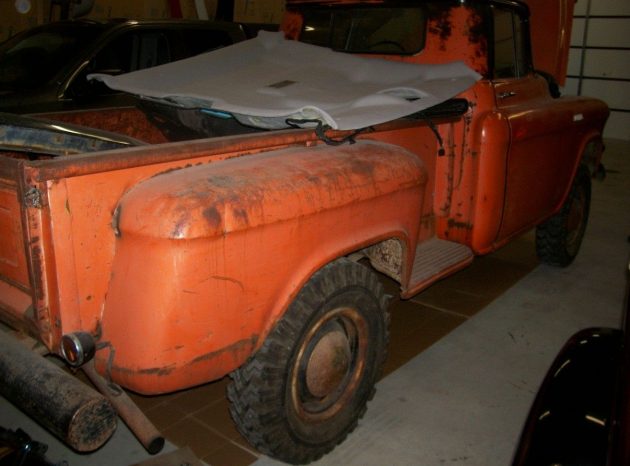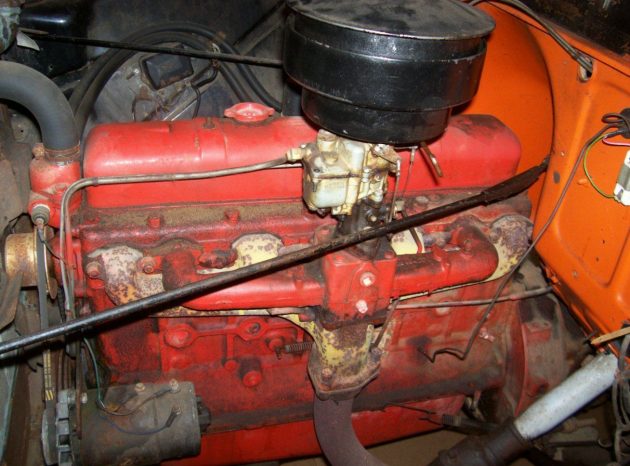Despite looking all the world like a factory-developed package, NAPCO pickups from GMC and Chevrolet were actually the brainchild of an aftermarket company from Minnesota. Now, production eventually moved in-house, and examples like this 1956 GMC pickup were likely built at the factory. Regardless of place of assembly, these high riding vintage 4x4s have a commanding presence all their own, and are quite desirable today. Find this GMC NAPCO 4×4 here on eBay listed for $17,500 or best offer.
The seller is very light on details, only noting that it runs and drives with very little rust. In some respects, there’s little else to tell, but what we can see shows a highly original interior with good glass, an uncracked dash pad, clear gauges and hardware like the chrome handles and window cranks still attached. In some ways, these GMCs could be seen as high end, with available options like a custom cab or Fleetside bed, to name a few. This truck obviously doesn’t have the latter, but I can’t even tell if it’s a stick or automatic based on these photos – can you?
The knobby tires are an appropriate look for a genuine NAPCO, but I don’t believe that rear bumper is original. The hubcaps on steel wheels are correct, but will need re-chroming. The photo gallery shows a surprisingly rot-free truck, with only one area of rot-through pictured that looks as if it’s a rear cab corner (not disclosed in the listing description). This is surprising, as the truck is located in Michigan, a climate more often associated with rust buckets than survivors.
The exterior color would appear to be original, based on the matching paint on the firewall. The NAPCO conversions were available in six-cylinder guise on the Chevys while the GMCs had the option of V8 power. No matter which marque and model you chose, having a factory-built 4×4 in the days of pickup trucks that weren’t guaranteed to be off-road capable was a treat – and likely why these NAPCOs remain so desirable today. Is the price for this project-grade example fair, or should a lower offer suffice?





To answer your question, this has a floor shift. The only smooth sided box prior to 1958, I believe, was the fiberglass sided box. I never saw one with a Napco GMC or Chevy.
I have owned 55 Chev Cameo for 50 years (GMC built the rarer Suburban equivalent), and I can state with some authority that the fiberglass box would not have stood up to any rigorous use. When I bought my truck, it had been used as the delivery truck for an auto electric firm, and the fiberglass looked like a middleweight fighter went 15 rounds against Mohamed Ali in his prime.
I really like the NAPCO conversions.
Bob
You can barely see see the shifter through the steering wheel spokes, but it’s there.
NAPCO trucks are good trucks and IMHO GMC won hands down with quality over Chevy.
I like it! I would love to have it but it’s out of my budget, unless I get lucky in the lottery. During the 50s I used to see more GMC 4x4s out west than Chevys. I don’t know why, because the dealers were all aggressive.
Transmission is a 4-speed with the compound low 1st gear. Bulletproof transmissions.The engine color and lack of much oil or grease means it has probably been rebuilt, or at least pulled and overhauled in the past. The 235 c.i. inline 6 had solid lifters. The long exhaust manifold sometimes cracks, meaning fix or replace. Not much rust for its age. A very very good starting place for a restoration, or clean it up drive it, enjoy it for the next 30 years or so.
Good NAPCO history. Somebody really dug into it.
http://www.napco4x4.org/history4.htm
I’ve got to stop looking at these so early since I’ve given up coffee, and again, they can ask what they want, but these were miserable trucks to drive, and tired, like this even worse.( I bet there’s half a steering wheel rotation of play) The only justification for this price, is it’s rarity. This was clearly some municipal or highway dept. truck, and probably saw little use. ( most likely, because it was pain to drive) Very, VERY few 4×4 pickups made it to civilian use in the 50’s and 60’s. We, in the midwest, never saw any until the 70’s, except for municipal use. 4×4’s were Jeeps and Scouts, and pickups just weren’t used in severe applications, until rural living demanded 4×4’s, especially for contractors just getting to these remote rural settings. Same thing, I feel these people that, for whatever reason, feel they have gold mines with these old trucks, but one ride will convince you, it ain’t so, and to update it would remove it’s rarity. Kind of a rough place to be
See the lumber wagon in action.
https://youtu.be/x5LYTkRjdno
Thanks, and that’s exactly what these were designed for. It’s when you take it on the highway, with those bias-ply tires, which might be split rims, can’t tell (radials would help some), the front wheels are following a different groove than the back wheels, and you’ll be fighting it all day long. We’ve come a long ways in 4 wheel drives.
Dave Mc- Great video! Thanks-
Sounds like they’re headed for mars!
Shoulda sent this truck with the Roadster, with Reddy Kilowatt at the wheel.
Growing up on a farming/ranching operation in the western plains, 4×4 trucks were around in larger numbers than anywhere else. Dad bought his first 4×4 (IH S-120) in 1956 and while he didn’t have real good luck with that first one (found out later that it was more the ranch foreman than the truck) we had 4×4 trucks ever since, and if we didn’t drive them we also had 1-ton to 3-ton trucks. There was a time when the family car was a ’60 Travelall. Maybe I got used to them but I have no qualms whatsoever of driving to Great Falls (100 miles one way) or Missoula (200+miles), or Kalispell, in a ’67 Ford F-250 4×4, or my ’79 GMC, or even Dad’s ’73 Dodge 300 4×4 flatbed dually. Sure they’re rough, maybe a little noisy; but they were reliable and you just drove a little slower. I delivered cattle to New Mildfred, CT, Raleigh, NC, and places in between, in that Dodge with a 30 ft. fifth wheel livestock trailer. Later, I hauled farm machinery in a ’72 Chevy C-65/427 hooked to a flatbed semi. Later upgraded to a GMC JJ 9500/same trailer. The lighter trucks rode a little better and quieter than the larger trucks but I went for a lot of marathon trips in them. What I’m saying is that, if a truck is mechanically sound, I don’t mind driving them, even if they’re rough and noisy. Our Chevy Avalanche is nice to drive; it’s got navigation, automatic driver position selection, heated seats, heated steering wheel (it doesn’t have an ATR thank goodness), satellite radio, bluetooth; it’s totally boring. In fact the only time I went white-knuckled in it was driving the road between Ouray and Silverton, CO. But if it breaks down I’ve got to take it to a dealer; the other stuff I can fix….
Although not nearly as common as today, 4x4s were fairly common in the mountains of Western Canada. An excellent example was to use them as service trucks. My uncle had one, with a 300 amp Lincoln in the box. He was regularly required to do welding jobs on logging and mining equipment, which requiring driving to remote sites in the mountains on roads that most people would not consider driving on. Some were even corduroy roads, made by making a carpet of logs and covering with fill. I used to go out on jobs with him, and the 4×4 and bull low gearing was essential.
Another item that my uncle had installed on the truck, were Warn locking hubs. This allowed him to disconnect the front drive system for better handling on the highway. It improved mileage and also reduced front drivetrain wear.
It was also common to see military surplus jeeps and Power Wagons, because there were not enough 4x4s available at a reasonable price.
You are correct that these things were no speed balls on the highway, but they did their primary job superbly.
Bob
Wouldn’t the original color be the blue on the interior? It looks to me that between the orange and the blacked out grill/headlight bezels that this was repainted at some point.
Maybe worth half the asking price. Maybe.
Would that engine not be a GMC power plant maybe a 270 or 248 ci it appears to have the GMC rocker cover and the oil lines going around to the remote oil filter
You’re right, they had their own 6cyl. engines. However, the V8 models used “truckized” Pontiac engines.
Definetly is a GMC made 6 cylinder engine and might even be a 228CI.
These were good engines.
You guys can pick this truck apart and say it isn’t roadworthy if you want. If I had this truck, it would make 3 or 4 trips a month to work, and annoy lots of people at the blistering speed of 45 mph. I bet if you were stuck in the mud with your Honda you would be really happy to see me and this truck with a 40 foot tow strap!
So much want! I have a weakness for old GMC’s, & a weakness for old 4 wheel drives. Combine the two & it’s a good thing it’s a little out of my current budget. The Napco conversions were diehard trucks, & although they weren’t that common, quite a large number have survived.
I do believe the color is original because of the factory markings on the firewall. Also, it’s advertised as a long box, but that sure looks like a short box to me.
I would really love to have this truck!
The seller has a lot of stuff for sale, including a mid 70’s Chevy fire truck & a 72 Monte Carlo.
Tyler –
The 98″ long bed was introduced in 1958. Before that, “long” beds were 90″ or so. I found this out when I bought a “long” stepside bed to replace my rusted out fleetside on a 66 C10. The gentleman selling it told me all stepside beds were the same between 1955 and 1966.
I was very surprised when I did the first test fit!
I ended up doing a whole lot of fab work to make the bed fit. :)
Thanks for the info on that!
First of all there are 3 versions of these Napco’s 1/2, 3/4, and 1 ton. Three bed lengths available. Gearing for the 1/2 ton was 3.90 to 1, 3/4 was 4.57, and 1 ton was 5.13. Three wheel sizes 16″, 17.5″ and 19.5″. The 1/2 ton 3100 road decent and the gearing is not bad with a 33″ tall tire and a radial makes them ride darn nice. Best 235/85/16, nice big side wall. I own a 1/2 Napco Chevrolet now, 235 6, 4 sp. Because Napco used the same differential gearing as standard Chevy a 3.38 to 1 gear set can be installed in the 1/2 ton front and back. Now your in the left lane.